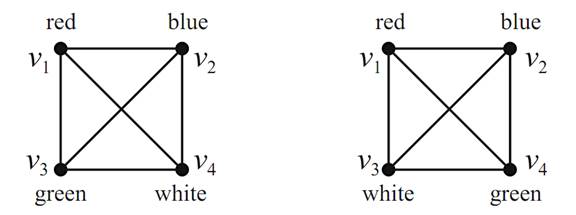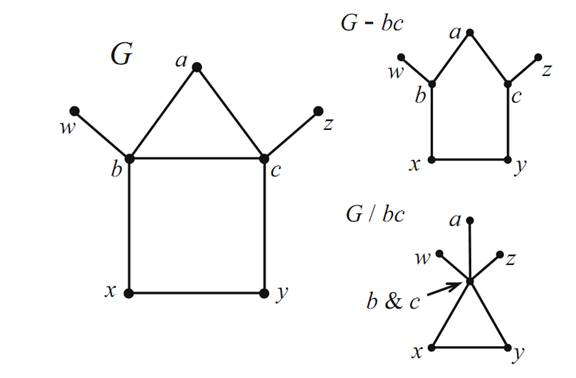Chromatic polynomials, developed by Birkhoff in the early 1900s as he studied the Four Color Problem, provide us with a method of counting the number of different colorings of a graph.
Before we introduce the polynomials, we should clarify what we mean by different colorings. Given a graph G, suppose that its vertices are labeled v1, v2, ... vn. A coloring of G is an assignment of colors to these vertices, and we call two colorings C1 and C2 different if at least one vi receives a different color in C1 than it does in C2. For instance, the two colorings of K4 shown in Figure 1.1 are considered different, since v3 and v4 receive different colorings.

FIGURE 1.1. Two different colorings.
If we restrict ourselves to four colors, how many different colorings are there of K4? Since there are four choices for v1, then three for v2,etc.,weseethat there are 4 · 3 · 2 · 1 different colorings of K4 using four colors. If six colors were available, there would be 6 · 5 · 4 · 3 different colorings. If only two were available, there would be no proper colorings of K4.
In general, define cG(k) to be the number of different colorings of a graph G using at most k colors. So we have cK4 (4) = 24, cK4 (6) = 360,and cK4 (2) = 0.
In fact, if k and n are positive integers where k ≥ n, then

Further, if k<n, then cKn(k)=0. We also note that cEn(k)= kn for all positive integers k and n. A simple but important property of cG(k) is that G is k-colorable if and only if cG(k) > 0. Equivalently, cG(k) > 0 if and only if χ(G) ≤ k. Finding values of cG(k) is relatively easy for some well-known graphs. Computing this function in general, though, can be hard. Birkhoff and Lewis [2] developed a way to reduce this hard problem to an easier one. Before we see their method, we need a definition.
Let G be a graph and let e be an edge of G. Recall that G−e denotes the graph where e is removed from G. Define the graph G/e to be the graph obtained from G by removing e, identifying the end vertices of e, and leaving only one copy of any resulting multiple edges.
As an example, a graph G and the graphs G − bc and G/bc are shown in Figure 1.2.
Theorem 1.1. Let G be a graph and e be any edge of G. Then

Proof. Suppose that the end vertices of e are u and v, and consider the graph G − e.
How many k-colorings are there of G−e where u and v are assigned the same color? If C is a such a coloring of G−e, then C can be thought of as a coloring of G/e, since u and v are colored the same. Similarly, any coloring of G/e can also be thought of as a coloring of G − e where u and v are colored the same. Thus, the answer to this question is cG/e(k).

FIGURE 1.1. Examples of the operations.
Now, how many k-colorings are there of G − e where u and v are assigned different colors? If C is a such a coloring of G−e, then C can be considered as a coloring of G, since u and v are colored differently. Similarly, any coloring of G can also be thought of as a coloring of G−e where u and v are colored differently.
Thus, the answer to this second question is cG(k).
Thus, the total number of k-colorings of G − e is

and the result follows.
For example, suppose we want to find cP4 (k). That is, howmany ways are there to color the vertices of P4 with k colors available? We label the edges of P4 as shown in Figure 1.2.

FIGURE 1.2. The labeled edges of P4.
The theorem implies that

For convenience, let us denote P4 − e1 and P4/e1 by G11 and G12, respectively (see Figure 1.3).

FIGURE 1.3. The first application.
Applying the theorem again, we obtain

Denote the graphs G11 − e2, G11/e2, G12 − e2,and G12/e2 by G21, G22, G23, and G24, respectively (see Figure 1.4).

FIGURE 1.4. The second application.
Applying the theorem once more yields

That is,

Thus

We should check a couple of examples. How many colorings of P4 are there with one color?

This, of course, makes sense. And how many colorings are there with two colors?

Figure 1.5 shows these two colorings. Score one for Birkhoff!

FIGURE 1.5. Two 2-colorings of P4.
As you can see, chromatic polynomials provide a way to count colorings, and the Birkhoff–Lewis theorem allows you to reduce a problem to a slightly simpler one. We should note that it is not always necessary to work all the way down to empty graphs, as we did in the previous example. Once a graph G is obtained for which the value of cG(k) is known, there is no need to reduce that one further.
We now present some properties of cG(k).
Theorem 1.2. Let G be a graph of order n. Then
1. cG(k) is a polynomial in k of degree n,
2. the leading coefficient of cG(k) is 1,
3. the constant term of cG(k) is 0,
4. the coefficients of cG(k) alternate in sign, and
5. the absolute value of the coefficient of the kn−1 term is the number of edges in G.
One proof strategy is to induct on the number of edges in G and use the Birkhoff–Lewis reduction theorem (Theorem 1.1). Before leaving this section, we should note that Birkhoff considered chromatic polynomials of planar graphs, and he hoped to find one of them that had 4 as aroot. If he had found one, then the corresponding planar graph would not be 4-colorable, and hence would be a counterexample to the Four Color Conjecture. Although he was unsuccessful in proving the Four Color Theorem, he still de-serves credit for producing a very nice counting technique.
_________________________________________________________________________________
1-Combinatorics and Graph Theory, Second Edition, John M. Harris • Jeffry L. Hirst • Michael J. Mossinghoff,2000,page(97-101)
2-G. D. Birkhoff and D. C. Lewis, Chromatic polynomials, Trans. Amer. Math. Soc. 60 (1946),no. 3, 355–451.
 الاكثر قراءة في نظرية البيان
الاكثر قراءة في نظرية البيان
 اخر الاخبار
اخر الاخبار
اخبار العتبة العباسية المقدسة


